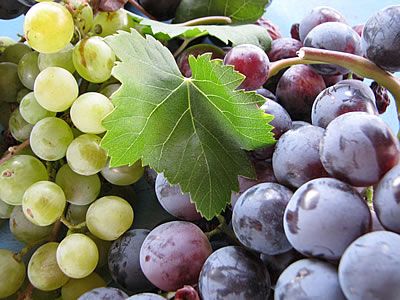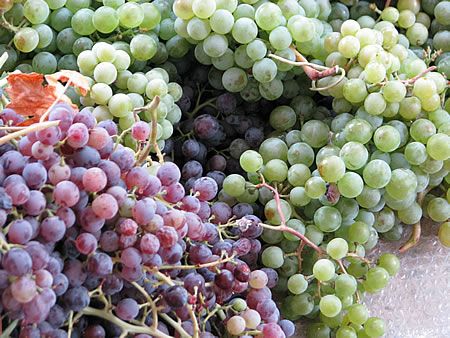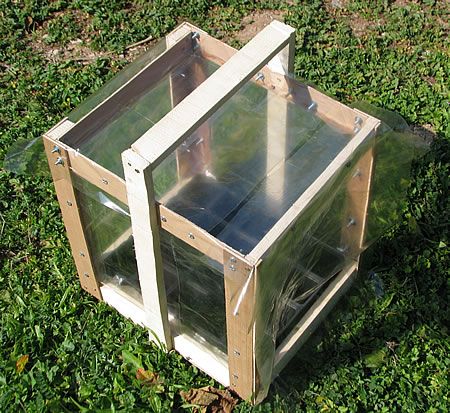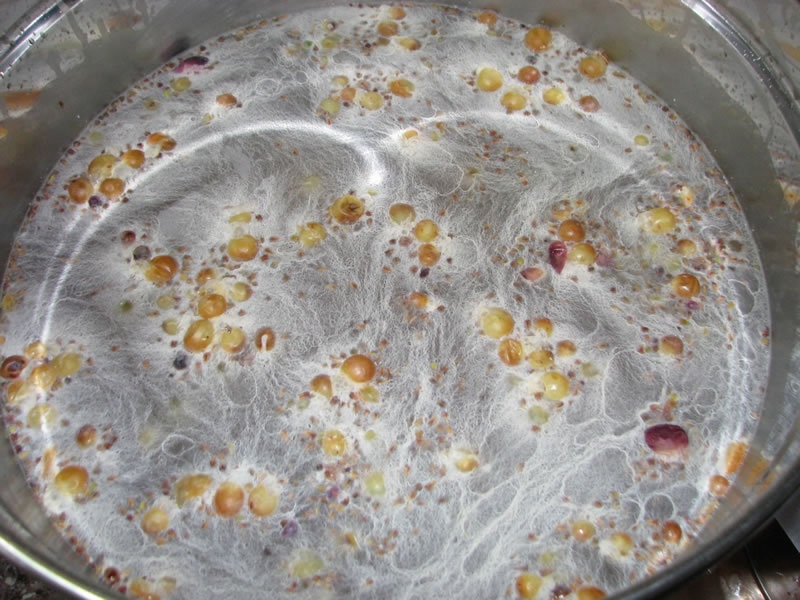August is the season when the grape picking begins in most areas of Greece. In many areas, it extends into September or even October depending on the variety.
This is the time to enjoy the fruits of the vine. It is the time when the efforts of the year will be justified. The vine that we have cared for all year long is ready to give us its juices.
We can use the must to make wine, petmezi (must syrup, grape treacle), or use it directly to make moustalevria (grape must pudding).
The steps for making the must are as follows:
- Harvest the grapes
- Crush the grapes
- Press the grapes to extract juice
- Clear the must
Harvesting of grapes
Harvesting should be done carefully so as not to hurt the grapes. It is advisable, during the harvest, to remove any damaged or dried out grapes from the bunches. You can do this later, but it is better now and will not seem like a chore.
If you are harvesting the vine to make must for wine, you should consult an oenologist about when is the right time. Usually grapes intended for wine are not harvested when they are fully ripe, but when their sugar level has reached the desired level.
If you are harvesting the vine to make must for petmezi (must syrup, grape treacle), then the grapes should be ripe (so ripe, that you can eat them comfortably).
Caution. Do not wash the grapes!
If it has previously rained, wait 3 days for the grapes to dry and then harvest.
Crushing of grapes – breaking of grape berries
The purpose of crushing the grapes is to break (split) the grape berries, extract its juice (must) and prepare it for the next stage which is pressing to extract all its juice.
Before crushing the grapes you have two options.
To remove the grape berries from the bunches and crush only the berries or
Keep the bunches as they are and crush them all together.
What will determine which method you follow is how you press the grapes in the next step.
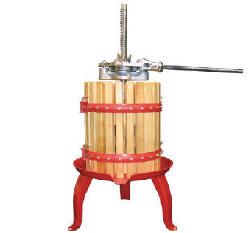
If you are going to use a wooden hand-held grape press (trocolo) I suggest you keep the grapes bunches as they are and crush them including rachis, peduncle and pedicels. This way, the material will not spill out from the openings between the woods.

If you are going to use a metal manual grape press, then it is best to keep only the grape berries. As metal grape presses are closed, there is no risk of material spilling out.
The breaking of the berries is traditionally done by pressing the grapes. You can even press the grapes into a large basin.
Alternatively, the crushing of the grapes is done with special machines called crushers. They come in manual and electric versions. Their prices range from 90 to 360 Euros for the household models.
The final result is as in the picture below.
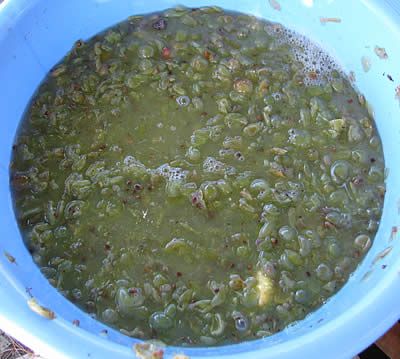
Grape squeezing (pressing)
Now it’s time to press the grapes to get all the juice out of the grapes.
At home, pressing is done using metal or wooden grape presses (trocola).
On the market you will find a variety of sizes, types and manufacturers. Prices for wooden manual grape presses range between EUR 170 and EUR 500. Prices for metal manual grape presses, which I have seen are smaller than wooden ones, range between EUR 65 and 170.
I used a wooden grape press.
We pour the pressed grapes into the grape press, after making sure to put a basin at the outlet to collect the must.
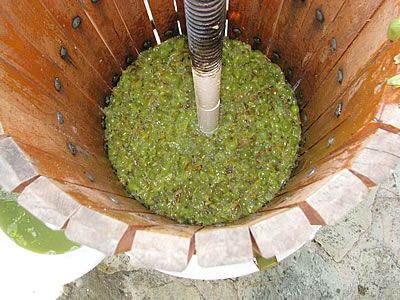
Immediately you will see the must flowing.
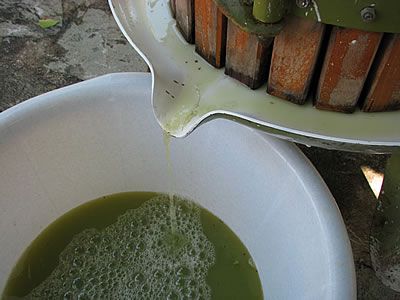
Then, as you will see in the next photos, we prepare the grape press to start pressing.
We place the two semi-circular pieces of wood on top of the grape pulp, and then pair and alternate the other sticks until we reach the top of the grape press.
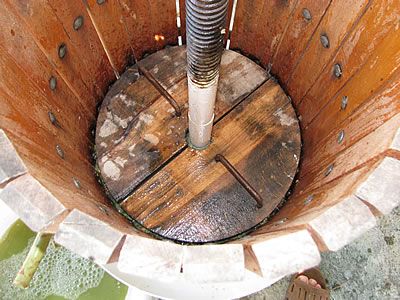
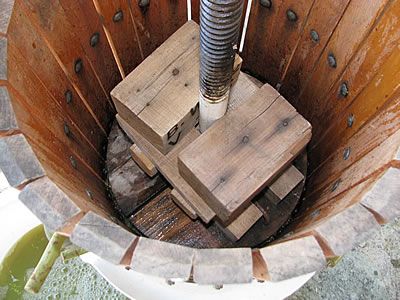
Finally, add the ratchet head.
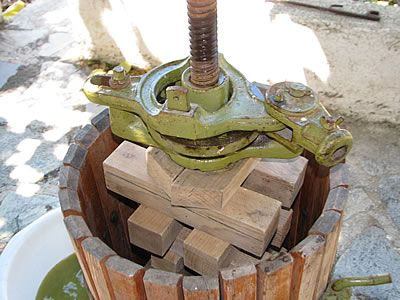
Attention. For convenience we should lubricate the ratchet shaft and mechanism. Lubrication should be done with olive oil and not other oil (e.g. engine oil) to avoid contamination of the wort with chemicals.
Start and work the mechanism, squeezing the grape pulp. The squeezing should be done gradually. In between, we should allow time for the must to flow.
Detailed instructions on how to operate a grape press can be found at
http://www.winegrapepress.com/wine_press_instructions.html
Then, a useful and informative video on how to prepare and operate a grape press (from 1:00 onwards):
Finishing the pressing, we have gotten the grapes must while our grape remains will look like the picture below. You can use this material in your compost. Nothing is wasted!
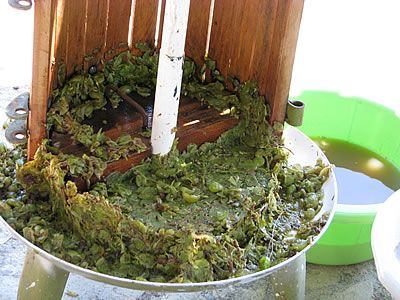
Cleaning the must
The next and final step is cleaning the must.
The purpose of cleaning is to remove from the must any grape residues or other foreign bodies that have fallen into it.
I personally do the cleaning by passing the wort simultaneously through tulle and a strainer with very small holes.
What you will notice is that the tulle dulls relatively quickly from the wort materials and you will need to clean or replace it regularly.
Good luck!
Tags: DIY • GRAPE CRUSHERS • GRAPE MOLASSES • GRAPES • I MAKE • MUST (GRAPE JUICE) • VINEYARD

